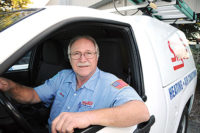What NHRAW wholesale-distributor members can do specifically to help their contractor customers, was the topic of discussion at two committee meetings (and doubtless in the ensuing hallway and cocktail reception conversations).
The wholesalers also learned the status of HFCs and global warming (see related article).
Spreading the word on training
How do wholesalers get the word out that they have some good training programs? By using more of today’s communication resources, for starters.Education Committee attendees noted that NHRAW has an extensive and growing inventory of training programs, including those of its longstanding Home Study Institute. Participants suggested beefing up availability on the association’s Web site, as well as exhibiting at the annual AHR Expo.
The Web site concept could be as simple as downloading training texts or as detailed as engaging in interactive training and test-taking with instant grading, attendees suggested.
One participant said it is necessary for NHRAW members to buy into the concept first. Then, he said, decisions could be made on what the Web site would look like.
It was also suggested that the use of CD-ROMs be looked at. Still others cautioned that a determination needs to be made about whether there is a large enough audience for such an extensive online commitment.
Committee members agreed to continue to mull over the Web site issue. For now, they said the association’s site will have regular e-mailed education-related tips added to it, as well as links to vocational programs of the educational institutions of guest educators who attend NHRAW conferences each year.
The exhibit booth at the AHR Expo would include information on association membership as well as details of training courses and other educational offerings. The committee deferred to the association staff to determine the financial feasibility of exhibiting.
More techs in the industry (and at the counter)
Wholesalers are being urged to step up their part in efforts to recruit and retain the folks that come up to their counters most every day: technicians.Three guests spoke at the Refrigeration Systems Council about the role of wholesalers in attracting and keeping technicians in the hvacr industry.
Rex Boynton of North American Technician Excellence talked about the Air Conditioning Excellence (ACE) exam offered through NATE. He suggested that wholesalers offer their places of businesses as sites for such tests, and promote the testing program to contractors and technicians who come in.
In effect, he said, each wholesaler involved in the program would become a “testing organization.”
He noted that some 12,000 technicians were NATE-certified as of early December. He said the goal for 2000 is to give 7,500 tests.
Since each technician can take two tests — a core exam and a specialty test (from which there are five to choose) — the objective was to reach more than 3,700 technicians. He said that as of December, more than 800 testing organizations were in place, including chapters of trade associations, schools, and businesses.
Steve Berkovitz, a professor at Massasoit Community College in Canton, MA, urged wholesalers to serve on high school, trade school, or vocational school advisory boards; volunteer to be guest speakers on career nights; and offer field trips to their supply houses. He said such an effort is needed to encourage young people to consider careers in hvacr.
He further suggested that wholesalers consider providing paid summer internships to students in hvacr programs. “But don’t hire them [full time] until they complete their education,” he added.
Berkovitz also said wholesalers should check with local schools if they need meeting space. His comment was based on his contention that a robust economy is drawing young people into the job market and out of the classroom. That, in turn, is creating underutilized school facilities.
Peter Walsh of Columbus (OH) Temperature Control encouraged his wholesaler peers to talk up “success stories” involving young persons in the hvacr industry. Take that person and his or her story “back to the high schools and to the high school counselors.”
Sidebar: Dormant global warming issue takes higher profile at conference
WASHINGTON, DC — HFCs made their mark in the hvacr industry because they didn’t have the ozone depletion problem of CFCs and HCFCs. The only “yellow light” concerning HFCs was their global warming potential (GWP).However, there is a chance that the issue could move to the front burner and a “red light” could go up.
Michael MacCracken, executive director of the National Assessment Coordination Office, U.S. Global Change Research Program and keynote speaker at the NHRAW International Conference here, did not refer to HFCs specifically, but indicated that not enough has been done to confront the global warming issue.
“Scientific findings are leading to proposals for limitations of emissions of greenhouse gases, including substances used in the refrigeration and air conditioning industry,” he said to an audience of wholesalers and manufacturers.
He noted that strides have been made to reduce emissions of greenhouse gases and fossil fuel-derived carbon dioxide. However, “We will be experiencing warming over the next several decades, even were we to sharply reduce emissions.”
Even the controversial Kyoto Protocol, considered by many to have created especially tough restrictions for the hvacr industry to deal with, was labeled by MacCracken “as only a rather modest start” in emission control.
He said there is a need for an “aggressive rate of improvement in energy efficiency, broad-based use of non-fossil technologies, and accelerated technology development and implementation.”







